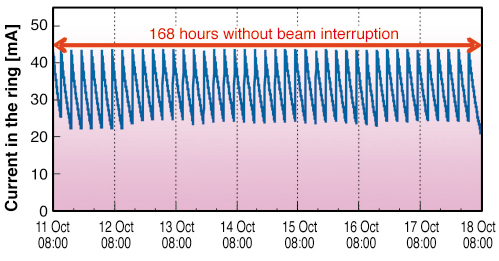- Home
- Users & Science
- Scientific Documentation
- ESRF Highlights
- ESRF Highlights 2006
- The X-ray Source
- Summary of machine operation
Summary of machine operation
In 2006, 687 shifts (5496 hours) of beam were initially scheduled. However, following an investigation made by an external company, the ESRF was informed in November 2005 that the Litaflex material used in the baking jackets installed during the early commissioning period contained asbestos. A detailed investigation revealed that Litaflex was present in about 60 different places inside the ring tunnel. Measurements were immediately performed to quantify the amount of asbestos fibres in the air of the ring tunnel. The results showed that no traces were present. Nevertheless, the presence of asbestos inside the foam of the material, even in low quantities, would have significantly complicated further interventions in the ring tunnel. The ESRF management decided to remove all pieces of Litaflex as soon as possible and in a single exercise. This was possible during the winter shutdown. Preparation work started early December 2005, immediately after the discovery. Due to constraints set by legal requirements, the removal of the litaflex by a specialised company could only be started on 3rd January 2006. It took four weeks to equip the tunnel and fully complete this operation, delaying the accelerator restart by two weeks. User service mode (USM) resumed on 6th February instead of 24th January, thus reducing the scheduled USM time over the year to 5248 hours, of which 23 hours were dedicated to radiation tests, so that 5225 hours remained for USM. Out of these scheduled 5225 USM hours, 5155 hours of beam were effectively delivered (including 36 hours of refill). This represents a beam availability of 98.66%. Dead time due to failures accounts for the remaining 1.34% (Table 5). This is the highest availability figure recorded since the construction of the ESRF.
 |
|
Table 5: Summary of the machine operation in 2006. |
The mean time between failures (MTBF) reached 61.5 hours, which is an excellent figure, higher than the 2005 score. Fourteen long delivery periods (i.e. more than 100 hours) without a single interruption took place in 2006, the longest of those was 177 hours (7 days)!
As an example, we highlight the 8th week of run 2006-04, when the beam was delivered in 4 times 10 mA filling mode for 168 hours without a single hitch despite the 42 refills (Figure 146).
 |
|
Fig. 146: 168 hours of beam delivery without interruption. |



